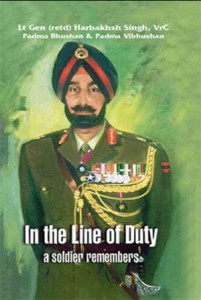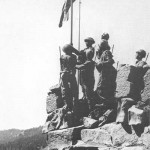I was stunned to receive this message and asked Brigadier Parkash to let the General Officer Commanding 15 Division know that he would not move back an inch from where he was, and that I and the Corps Commander were coming to meet him. I drove the Jonga in which we travelled. It was not long before we saw the havoc that the enemy air had caused on the GT Road. Vehicles were burning here and there, while there were craters on the road, and enemy aircraft were still flying over head. We saw 15 Division Administrative Echelon vehicles abandoned on the road, the drivers having run away, leaving some of the engines still running. We saw an armoured carrier standing in the middle of the road, with its keys still in it. I had it removed off the road. We were directed by the Divisional Military Police to the General Officer Commanding, Major General Niranjan Prasad, who was hiding in a recently irrigated sugarcane field! He came out to receive us, with his boots covered ‘with wet-mud.
Also read: India can make major defence equipment
He had no head-cover, nor was he wearing any badges of rank. He had stubble on his face, not having shaved, contrary to the custom before the start of an operation. Seeing him in such a state, the first question I asked him was whether he was the General Officer Commanding a Division or a coolie? Why had he removed his badges of rank and not shaved, I asked? Of course, he had no answer. We were standing in the open, and, naturally, the men of his Headquarters had formed a circle around us, though at a distance. At one stage a couple of enemy fighter planes flew over head, strafing vehicles on the road, and Niranjan Prasad tried to pull me to safety under the cover of a bush nearby. I had to shout at him to explain that the enemy aircraft were not interested in us, nor could they see us. What they were after were his vehicles that had been abandoned the road, head-to-tail. I asked him where his reserve Brigade Commander was. He shouted: “Pathak, Pathak” and Pathak came to us, his face as white as a sheet.
Seeing him in such a state, the first question I asked him was whether he was the General Officer Commanding a Division or a coolie? Why had he removed his badges of rank and not shaved, I asked?
I asked him where his men (F Group) were, and he answered that they were following, but they were inoperative, because they had suffered very heavy casualties from enemy aircraft. I, naturally, asked him how many casualties they had suffered, and he replied, “Nearly 30 wounded”. I said, “30 out of 4000 (the strength of his Brigade) and you say your Brigade was inoperative!” I asked him to pull himself together and then gave him his orders, on the map and on the ground, for the next phase of his advance. He was to take his Brigade along the distributory, shown on the map, and on reaching the Ichhogil Canal, to turn left and re-capture the bridge on the GT Road near Dograi. In order to give his Divisional Commander another chance, I asked Niranjan Prasad to ”keep an eye on his Brigade, and report to his Corps Commander, in the morning, regarding the progress of the operations”.
I had known Niranjan Prasad for a long time. He had already, on two occasions, acquitted himself badly while commanding a Division. The first time was in NEFA and then later, while commanding 25 Infantry Division, at Rajouri. I was also aware that each time he had written a representation against his senior Commanders. I had found him deficient in command of 15 Infantry Division as early as June that year, and had said as much to General Chowdhary when he visited XI Corps during an Exercise. But the Chief chose to disregard my suggestion for according to him Niranjan Prasad had very close political connections with higher-ups in Delhi!
So, this time, sensing that I might remove him from command, General Niranjan Prasad had apparently already written out a representation against me in his note book which he kept in his brief case along with some other secret and confidential papers. I now state what was revealed in a Court of Inquiry which General Officer Commanding XI Corps ordered, to go into the circumstances that prevented General Niranjan Prasad from visiting his Reserve Brigade, under Brigadier Pathak, who had been, ordered by me to carry out a certain operation, which Niranjan Prasad had been ordered to supervise. The story goes, that on the morning of the 7th of September, Niranjan Prasad sent for an officer to lead him to the Brigade’s position, and set off towards it along the distributory, which was marked on the map. He was in the Jonga in front, with his\ADC, while two jeeps, with his escort in them, were following him. As he progressed along the distributory, he was fired at by a distant Medium Machine Gun. Both he and his ADC abandoned the Jonga and took cover in a field of crops nearby, as did the escorts.
 A little later, Niranjan Prasad decided to return to his Headquarters and asked that the last jeep be turned around for this purpose. Both he and his ADC took off in this jeep, leaving the escort to make their way back on foot. Thus he left the brief-case he was carrying, with all the papers in it in the Jonga, which apparently also had his formation flag and star plates on it. This Jonga, along with his brief-case (and papers) was subsequently captured by the Pakistanis, who started broadcasting the contents of his brief-case, including his representation against me over the air! On the basis of the proceedings of the Court of Inquiry, General Officer Commanding XI Corps wanted to try Niranjan Prasad by a Court Martial, but the Chief of the Army Staff, General Chowdhary, sent for Major General Niranjan Prasad, and, we later learnt, asked him to resign.
A little later, Niranjan Prasad decided to return to his Headquarters and asked that the last jeep be turned around for this purpose. Both he and his ADC took off in this jeep, leaving the escort to make their way back on foot. Thus he left the brief-case he was carrying, with all the papers in it in the Jonga, which apparently also had his formation flag and star plates on it. This Jonga, along with his brief-case (and papers) was subsequently captured by the Pakistanis, who started broadcasting the contents of his brief-case, including his representation against me over the air! On the basis of the proceedings of the Court of Inquiry, General Officer Commanding XI Corps wanted to try Niranjan Prasad by a Court Martial, but the Chief of the Army Staff, General Chowdhary, sent for Major General Niranjan Prasad, and, we later learnt, asked him to resign.





nirajan prasad, bm kaul, kishanpal, gen thapar, there are plenty in our senior echelons who should have faced a firing squad. but alas for the faith of the public to be not shaken in the last argument of the indian state our armed forces people like these get away.
Niranjan Prasad was a coward who abandoned his position and a disgrace to our Army.